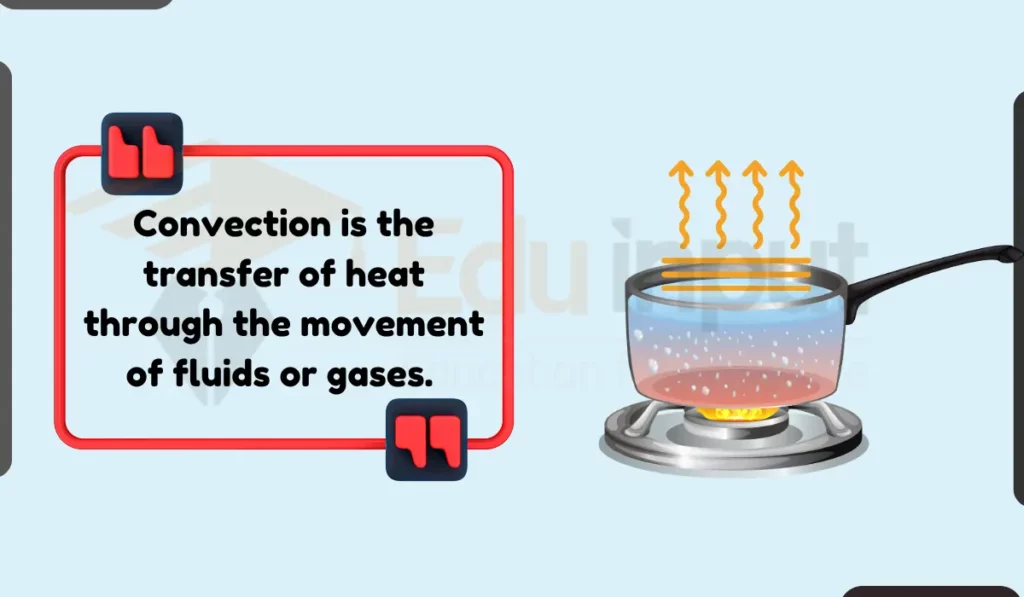Convection-Defnition, Types, Examples, and Application
Convection Definition
Convection is the transfer of heat through the movement of fluids or gases. There are a few different driving forces that lead to convective heat transfer. Convection occurs when thermal energy is transferred by the movement of fluids.

Boiling water in a pot, Air rising above a fire, and Sea breeze on a hot day are a few situations in which convection occurs.
Types of Convection
There are two main types of convection, but there are some other types in certain conditions. So here are 5 types of convection:
1: Natural Convection
Natural convection is heat transfer through fluid movement caused by density differences due to temperature variations in the fluid. Heated fluids become less dense and rise, while cooled fluids sink, creating circular currents.
Natural convection occurs due to inherent buoyancy forces and does not require an external force. It is observed in scenarios like hot air rising above a fire and ocean currents developing.
2: Forced Convection
Forced convection is heat transfer through fluids moved by external mechanical forces such as fans, pumps or stirrers. This external forcing increases the rate of heat exchange as compared to natural convection.
Forced convection takes place in systems like air conditioners, car radiators, computers, and other devices where liquids or gases are made to circulate vigorously.
3: Free Convection
Free convection refers specifically to fluid movement caused by density variations arising from temperature differences, without any influence from external forces.
It is a specialized case of natural convection where any minor external forces, like gravitational force, are considered negligible. Heating and cooling of the fluid induces circulation solely due to inherent buoyancy forces.
4: Mixed Convection
Mixed convection occurs when both natural and forced convection take place simultaneously. Fluid flow and heat transfer are influenced by not just external mechanical forces like fans, but also inherent buoyancy forces produced from temperature differences within the fluid itself. Both effects drive the fluid movement.
This phenomenon is common in scenarios transitioning between free and forced convection.
5: Turbulent Convection
Turbulent convection happens when instabilities cause the fluid flow to become highly disordered and chaotic. The irregular velocities increase mixing and result in rapid heat transfer between the fluid layers.
However this turbulence also introduces complex and unpredictable fluid motions and thermal gradients. Turbulence usually occurs at very high flow speeds.
Convection Examples
Convection occurrs in various natural and engineered systems. Here are some examples:
Natural Convection Examples
- Hot air rising above a fire or radiator.
- Ocean currents driven by temperature differences.
- Land and sea breezes caused by differential heating of land and water.
- Formation of clouds due to rising air and condensation.
- Upward movement of molten rock in the Earth’s mantle.
Forced Convection Examples
- Air conditioning and heating systems using fans or blowers.
- Cooling systems in cars and computers using fans or pumps.
- Stirring hot soup or coffee.
- Wind blowing over a flag or sail.
- Convection ovens using fans to circulate hot air.
For Detailed insight, Read Examples of convection
Factors Affecting Convection
Here are a few Factors that Affect rate of Convection:
- Density Difference
- Viscosity
- Heat Capacity
- Surface Area
- Exposed Surface Area
- Thermal Conductivity
- Acceleration Due to Gravity
- Boundary Conditions
- Shape of the Container
Applications of Convection
Here are a few Applications of Convection:
1. Heating Systems – Warms spaces by circulating heated air or fluid.
2. Cooling Systems – Prevents overheating by dissipating excess heat.
3. Weather Phenomena – Drives atmospheric circulation, impacting weather.
4. Oceanic Circulation – Influences large-scale ocean currents and climate.
5. Cooking Processes – Ensures even heat transfer within food items.
6. HVAC Systems – Regulates indoor temperatures and air quality.
7. Geological Processes – Affects geological phenomena like plate tectonics.
8. Industrial Processes – Controls heating and cooling in various industries.
9. Thermal Comfort in Buildings – Considers convection for occupants’ comfort in building design.
10. Renewable Energy Systems – Uses convection in solar water heaters for sustainable energy.







Leave a Reply